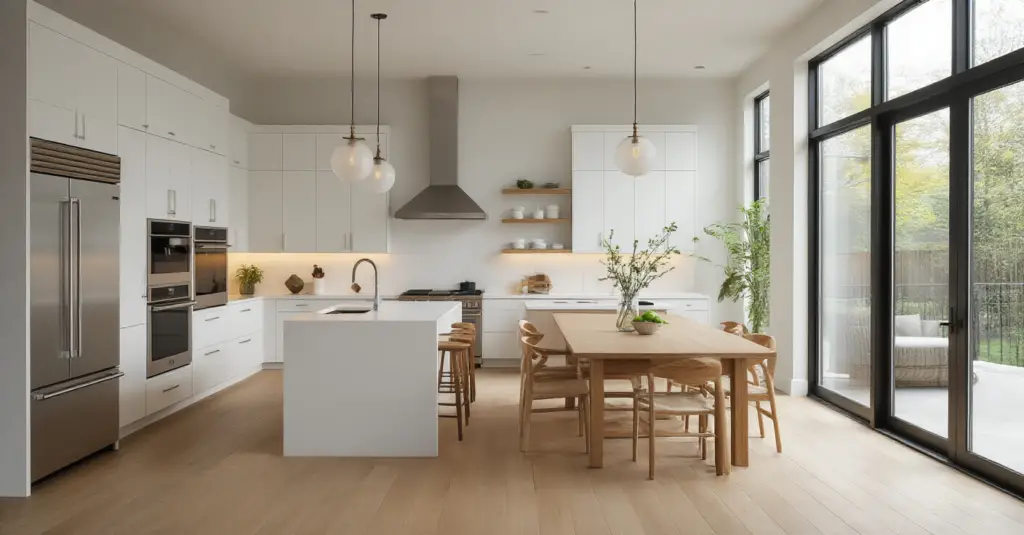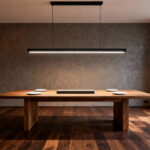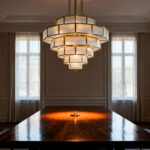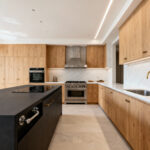Can we talk about why so many people get “modern” kitchens wrong? For years, I watched magazines showcase these spaces that looked like sterile, untouchable art galleries. They were all sharp angles, cold surfaces, and zero personality. I used to think, “Who actually lives here? Where do you put the sticky toddler handprints or the grocery bags when you’re trying to find your keys?” It felt like design that was actively hostile to real, messy, beautiful life.
Then I realized the problem wasn’t modern design; it was a misunderstanding of it. A truly modern kitchen isn’t about being cold or trendy. It’s about being smart, thoughtful, and fundamentally designed for people. All people. A great modern kitchen is, at its heart, a universally designed kitchen. It anticipates your needs now, and the needs you’ll have ten years from now. It’s a space that works whether you’re a 6-foot-tall chef, a child learning to bake, or a grandparent using a walker. It’s about creating a beautiful space that makes life easier, not harder. So, let’s ditch the idea of a museum and talk about what really matters.
Laying the Groundwork: Strategic Planning for Your Modern Kitchen (Part 1)
This is the part everyone wants to skip. I get it—picking out tile is way more fun than planning layouts. But trust me, a little thinking here saves a world of headache (and money) later. This is where we make sure your kitchen actually works before we make it pretty. It’s about building a strong foundation so all the stylish details have a chance to shine.
1. Mastering the Open-Concept Flow for Seamless Living
Everyone says you need an open-concept kitchen, but nobody talks about the potential downsides. I once had a client who tore down every wall, and while it looked stunning, she called me two months later in tears. The noise from her husband’s smoothie blender made it impossible for her to hear her morning news, and cooking smells lingered in the living room for days. A truly successful open concept isn’t just about a lack of walls; it’s about creating distinct, functional zones within a larger space. It’s about making sure there’s enough room to maneuver, whether you’re carrying a toddler or using a wheelchair.
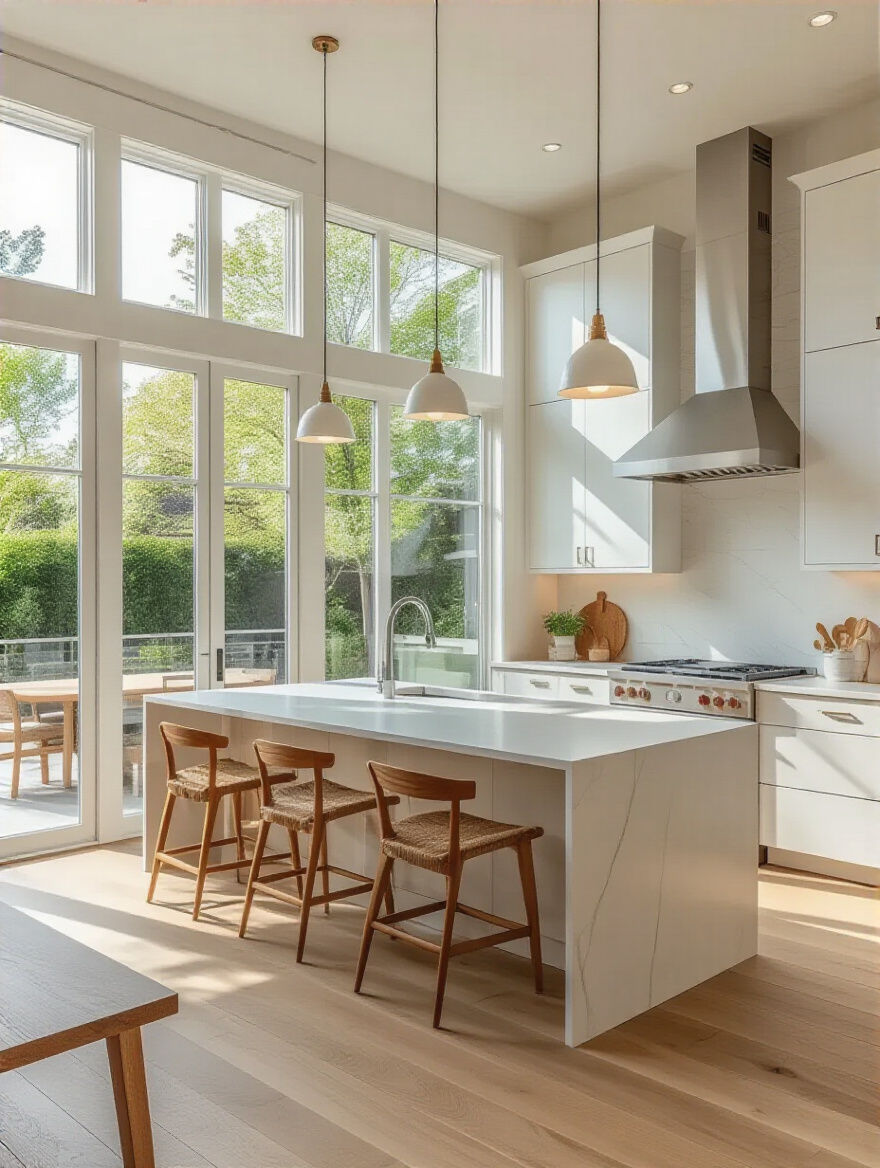
The real story here is thoughtful flow. Your goal should be wide, clear pathways—I aim for at least 42-48 inches between counters—so multiple people can work without bumping into each other. Use a large island to create a soft boundary between the cooking and living areas. And please, invest in a quiet, powerful range hood. That’s the shortcut everyone forgets. Good design here means you get all the social benefits of an open space without sacrificing peace and quiet. It’s about connection, not chaos.
With your layout planned for real life, we can move on to the elements that define the space visually and functionally, starting with the cabinetry.
2. Prioritizing Minimalist Cabinetry and Integrated Storage Solutions
Let’s call out the BS right away: minimalist cabinetry isn’t just about flat, handle-less doors. A kitchen can look perfectly sleek on the outside and be an absolute disaster on the inside. True minimalism is about function first. The magic is in creating storage so smart that it simplifies your life. Think full-extension drawers instead of deep lower cabinets, so you never have to get on your hands and knees to find a pot lid again. That’s good for your back today, and it’s a lifesaver as you age.
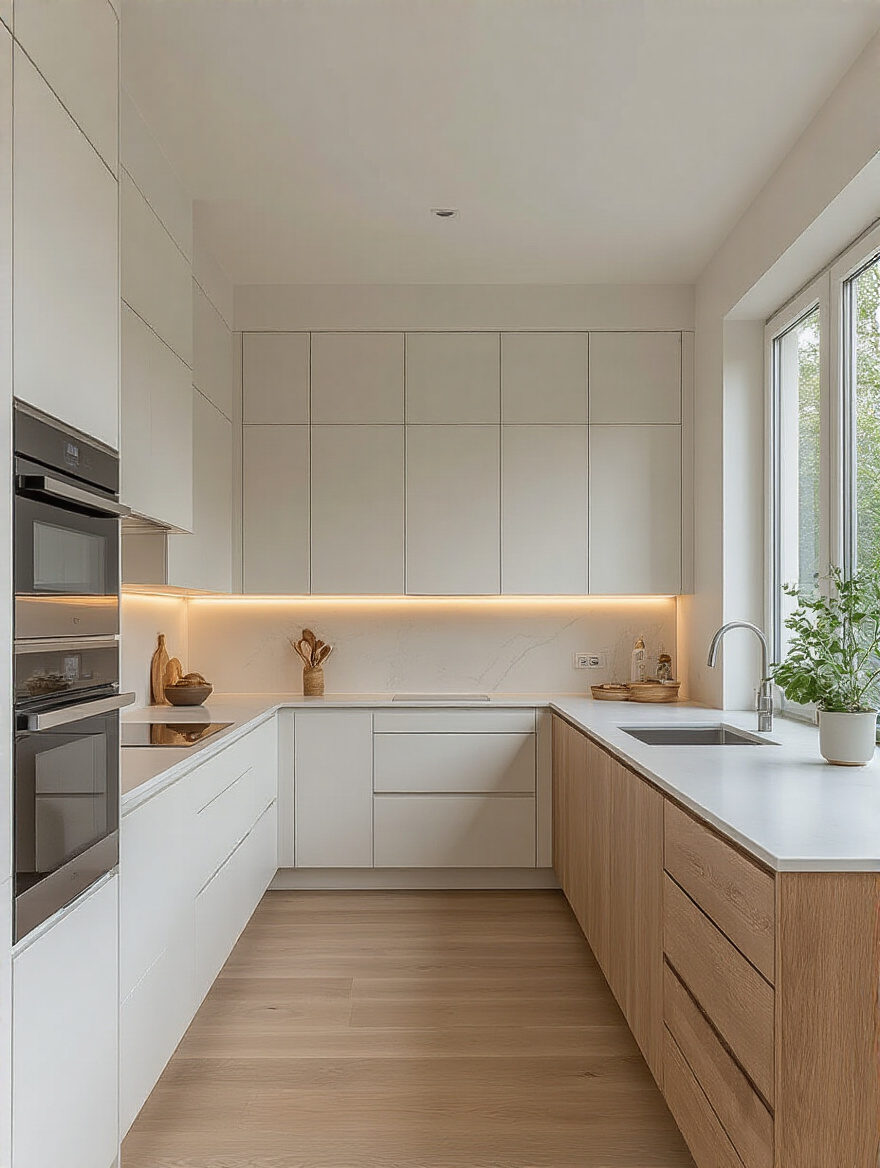
For that clean look, I love push-to-open mechanisms or integrated channel pulls. They not only look seamless but are a dream for anyone with arthritis or limited hand strength—no knobs to pinch or grab. And my favorite trick? An “appliance garage” with a pocket door. It keeps the toaster and coffee maker hidden but accessible, clearing your countertops of daily clutter. It’s not about having less; it’s about having smarter, more accessible storage for the things you actually use.
Getting your storage right means your beautiful new countertops will stay clear and functional, which brings us to one of the most important surfaces in the room.
3. Selecting Durable, High-Performance Countertops for Visual Appeal
I’ll confess: I used to be seduced by the beauty of materials like marble. Then I saw a client’s stunning new marble island get hopelessly stained by a single glass of red wine at its first-ever party. The heartbreak was real. When people ask me what countertops to get, I don’t start with what’s prettiest. I ask, “How do you live?” Do you have kids who spill juice? Do you roll out dough? Do you host parties where people leave wet glasses everywhere? Be honest with yourself.
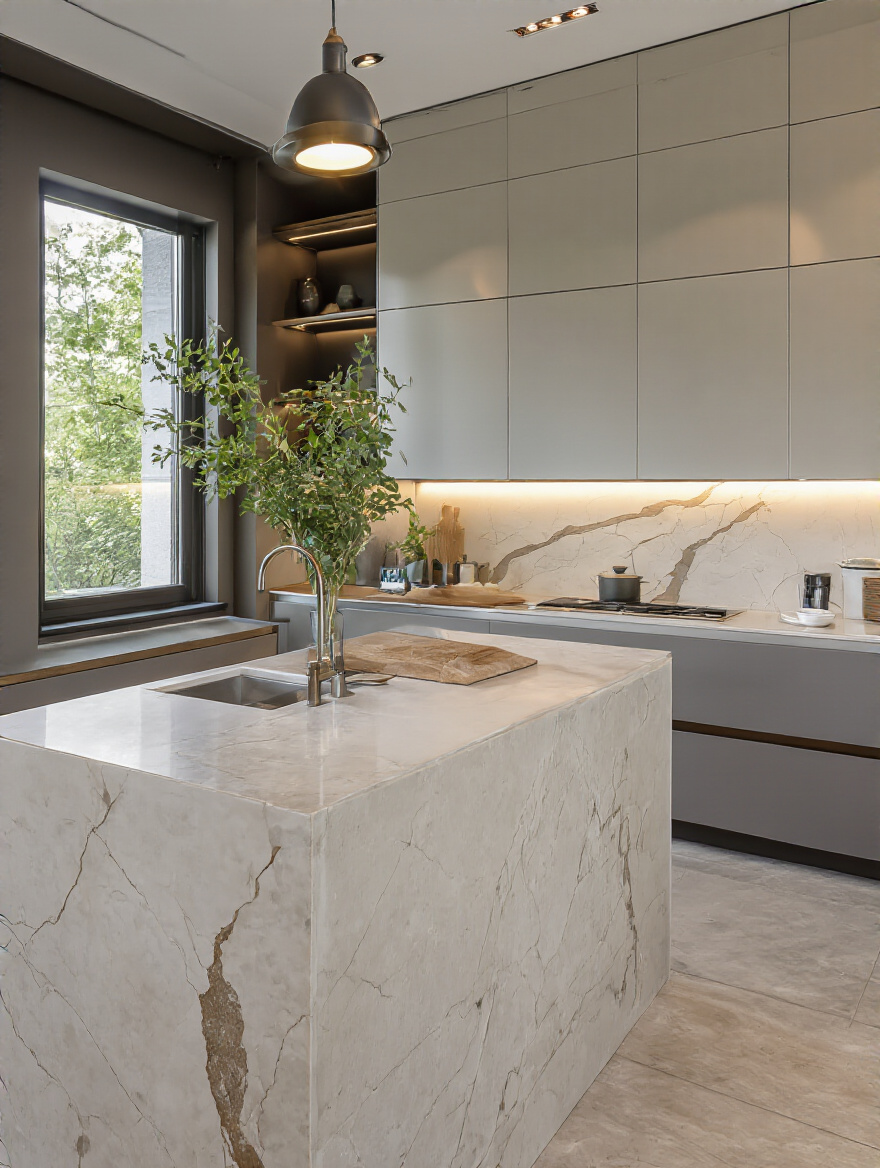
For most people, the answer is engineered quartz. It’s bulletproof. It gives you the look of natural stone without the anxiety of staining, scratching, or sealing. You can get it in huge slabs to minimize seams (which are just grime traps, anyway) and even run it up the wall for a backsplash. The shortcut here is to get samples and abuse them. Leave coffee, wine, and mustard on them overnight. See what survives your real life. Your countertop is a work surface first and a showpiece second. A truly modern choice is one that looks great without making you a slave to its upkeep.
Once you’ve chosen a workhorse countertop, it’s time to shine a light on it—literally.
4. Integrating Smart Task and Ambient Lighting Fixtures
You know what people always ask me? “Sam, what’s the single biggest mistake people make in their kitchen?” My answer is always the same: bad lighting. It doesn’t matter how beautiful your kitchen is if you can’t see what you’re doing. A modern lighting plan is about layers. It’s not just one sad fixture in the middle of the ceiling. It’s a thoughtful combination that makes the room safer, more functional, and more beautiful.

Start with the non-negotiable: under-cabinet task lighting. It illuminates your countertops directly, eliminating shadows and reducing eye strain. This is critical for everyone, but especially as our eyes age. Then, add ambient light from recessed cans or a central fixture for overall illumination. Finally, add accent lighting, like a beautiful pendant over an island, for style and mood. The “smart” part isn’t a gimmick; it’s about control. Putting everything on dimmers allows you to go from bright, focused light for chopping vegetables to a warm, soft glow for dinner. That flexibility is the essence of modern design.
Lighting sets the mood and highlights the colors you choose, which is our next crucial decision.
Laying the Groundwork: Strategic Planning for Your Modern Kitchen (Part 2)
We’re still in the planning phase, but now we’re getting into the elements that really start to shape the personality of your kitchen. Color is incredibly powerful—it can make a space feel bigger, calmer, and more cohesive.
5. Embracing a Cohesive Neutral Color Palette with Purposeful Accents
Some people hear “neutral” and they immediately think “boring.” But that’s a complete misunderstanding. A neutral palette of whites, soft grays, warm woods, and beiges is your secret weapon for a timeless kitchen. It’s a calming, versatile backdrop that doesn’t scream for attention. It maximizes light, makes a small space feel larger, and creates a sense of serenity that is so welcome in the busiest room of the house. Most importantly, it’s a canvas that can evolve with you.
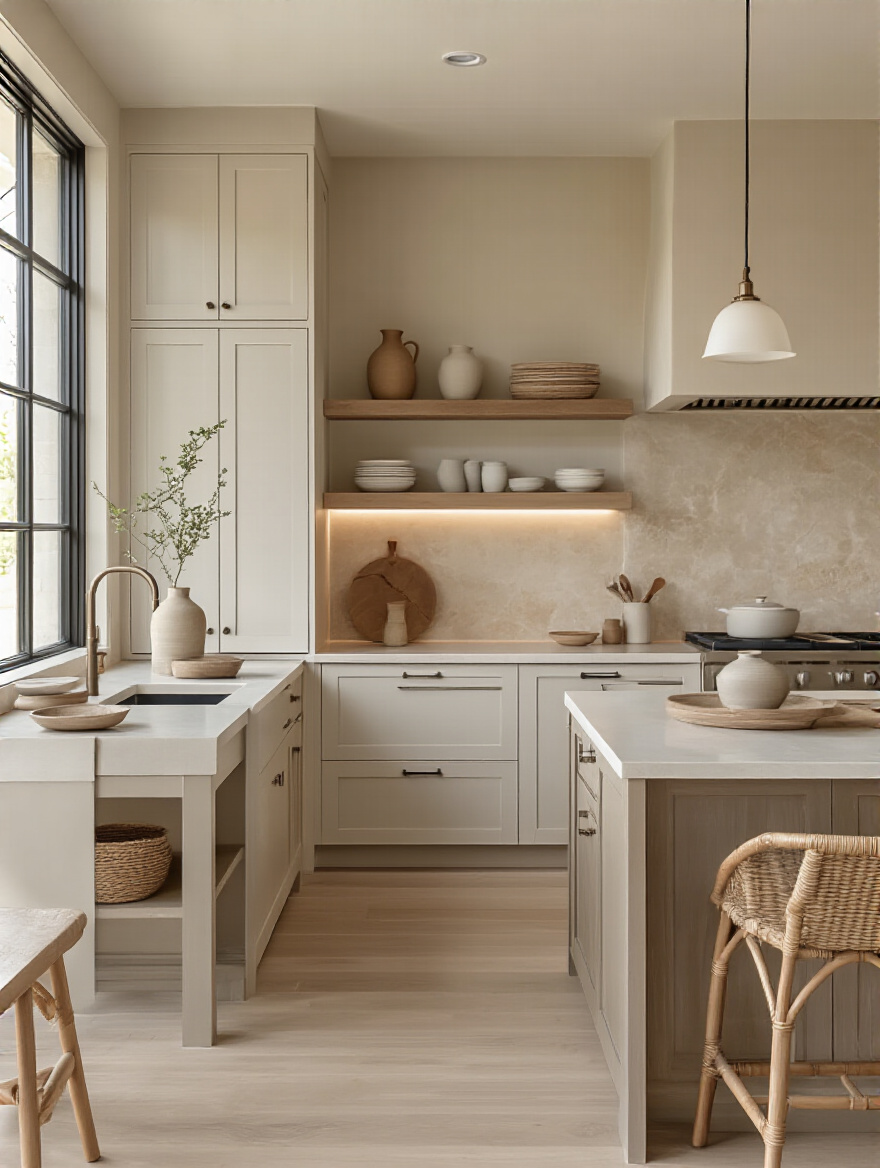
The key is to bring in layers of texture to keep it from feeling flat—think a subtly veined countertop, a tile with a handmade feel, or the grain of wood cabinetry. The “purposeful accents” are where your personality comes in. Use artwork, a colorful rug, or even your stand mixer to bring in pops of color. The brilliant thing is that these are the easy and inexpensive things to change. When you get tired of emerald green in a few years, you can swap out your tea towels, not your entire set of cabinets. That’s smart, sustainable design.
This timeless foundation allows the core design elements we choose next to really stand out.
Core Design Elements: Shaping the Modern Aesthetic (Part 1)
Now for the fun stuff. These are the big-ticket items that define the look and feel of your modern kitchen. By making smart, integrated choices here, we create that seamless, uncluttered look that is both beautiful and incredibly easy to live with.
6. Opting for Integrated, Panel-Ready Appliances for a Streamlined Look
Picture this: You’re standing in your kitchen, and instead of a wall punctuated by a big stainless steel box, you see a seamless bank of beautiful cabinetry. That’s the magic of integrated, panel-ready appliances. Your refrigerator and dishwasher simply disappear behind custom panels that match your cabinets. It’s a high-end look, for sure, but the benefit goes beyond pure aesthetics. It creates an uninterrupted visual line that makes a kitchen feel bigger and much more calming.
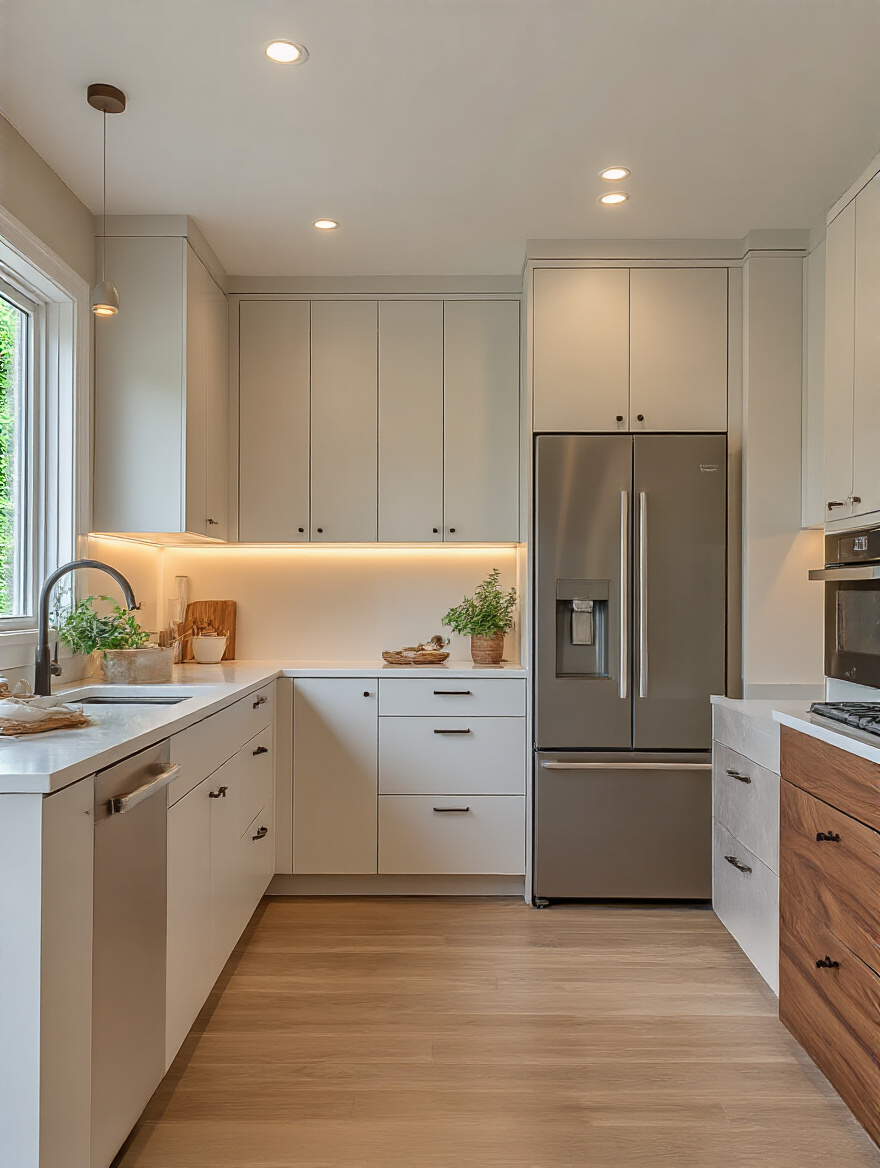
This isn’t about hiding your appliances in shame; it’s about creating a cohesive, intentional design. It quiets the visual noise. I’ve seen this completely transform smaller kitchens, making them feel less like a cramped utility room and more like a beautiful piece of custom furniture. The shortcut is to plan this from the very beginning with your kitchen designer and cabinet maker. It requires precise measurements, but the payoff in creating a serene, unified space is immense.
This feeling of seamlessness shouldn’t stop at your appliances; it should extend all the way down to the floor.
7. Choosing Large-Format Tile or Polished Concrete Flooring for Durability
Let’s talk about grout. It’s a magnet for dirt, a pain to clean, and it chops up your floor into a busy grid. The modern solution? Minimize it. Large-format tiles (think 24×24 inches or even bigger) drastically reduce the number of grout lines, creating a visually cleaner and more expansive look. Fewer lines mean less scrubbing and a floor that looks sleek and uniform. It’s a simple change with a massive impact.
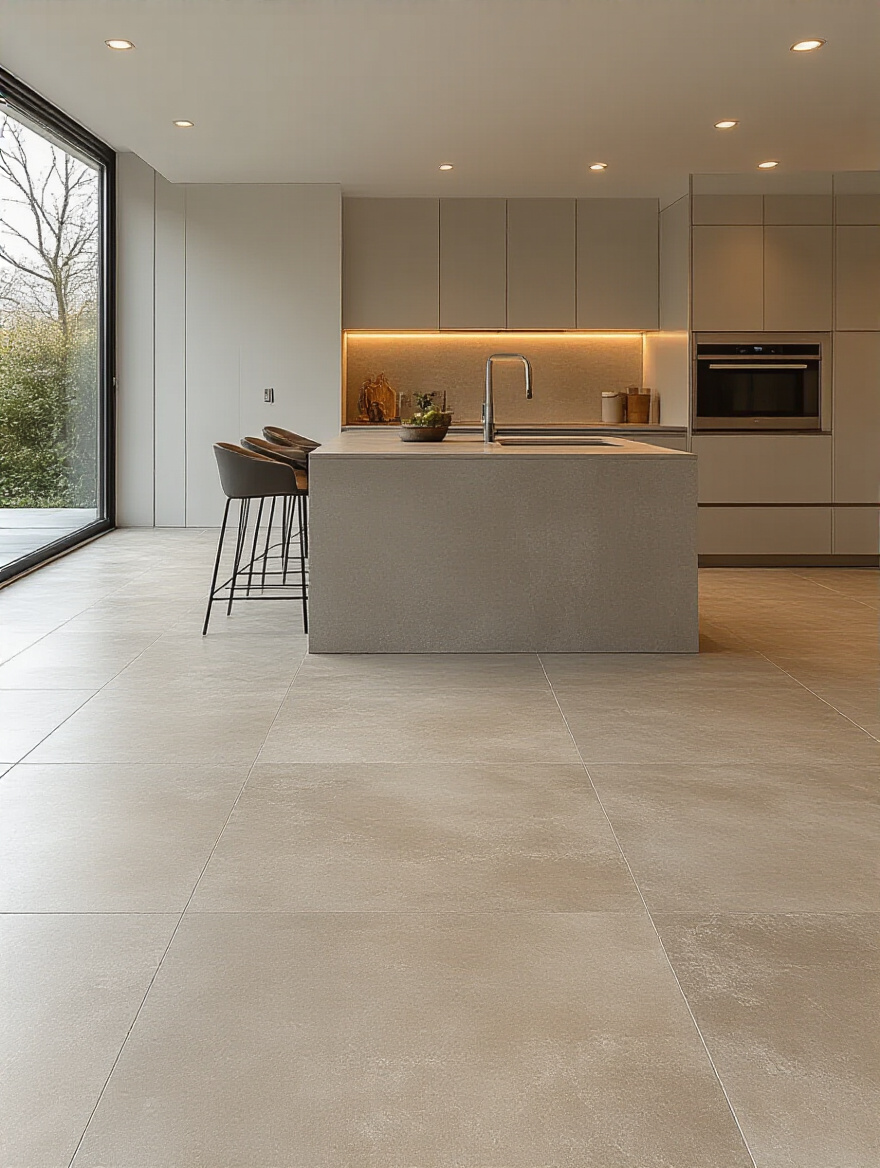
An even more seamless option is polished concrete. It’s incredibly durable, easy to clean, and gives you a sophisticated, industrial-chic vibe. And a great universal design feature of both is the smooth, continuous surface they create. There are no transitions or bumps to trip over, making it a safer choice for kids, elders, and anyone with mobility challenges. The myth is that these floors are cold, but they are perfect for radiant in-floor heating, giving you a surface that’s warm and comfortable underfoot.
From the floor, our eyes travel up to another critical surface: the backsplash.
8. Designing a Seamless Backsplash for Cohesive Visual Continuity
Just like with flooring, the goal for a modern backsplash is to reduce visual clutter. Forget busy mosaic patterns or tiny tiles with a million grout lines. Instead, think about continuing the same material from your countertop right up the wall. This is called a slab backsplash, and it’s the ultimate in clean, seamless design. It creates a stunning, monolithic look that is also incredibly practical—with zero grout lines, cleanup is as simple as wiping down a single surface.
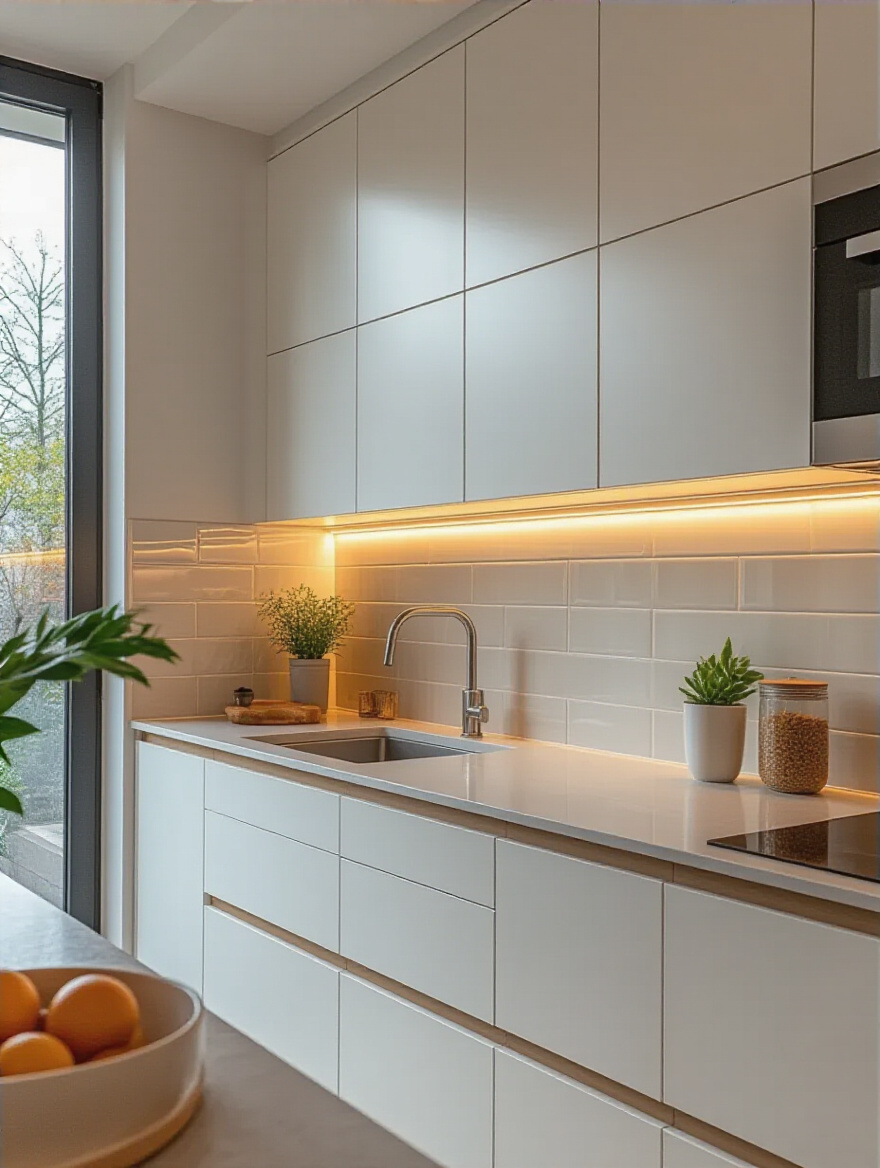
If a full slab isn’t in the budget, you can get a similar effect with large-format tiles and a color-matched grout. The trick is to find a grout that blends in so perfectly that the individual tiles almost disappear. This continuity helps the kitchen feel more spacious and serene. It’s one of those details that you might not consciously notice, but you feel its calming effect. The space just feels more resolved and peaceful.
And now for the “jewelry” of the kitchen, the small details that tie everything together.
9. Updating Hardware with Clean Lines and Matte or Metallic Finishes
If you want the single fastest, most affordable way to update your kitchen, change the hardware. It’s like changing the buttons on a coat—it can completely transform the entire look. Ditching dated, ornate knobs for sleek, simple bar pulls in a matte black or brushed brass finish will instantly make your cabinets feel more modern. The key is choosing hardware with clean, geometric lines that feel good in your hand.
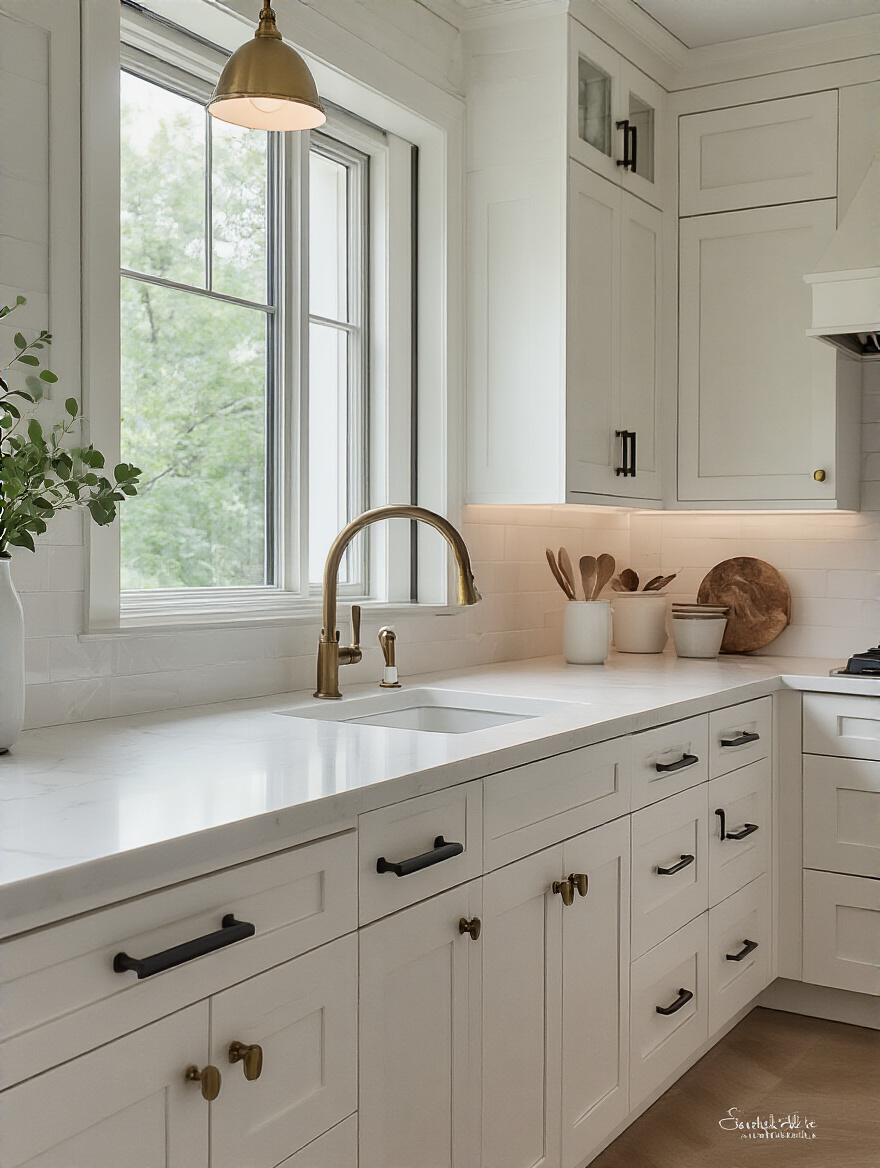
But here’s the shortcut you need to know: measure the distance between the screw holes on your current hardware before you go shopping. This is the “center-to-center” measurement. Finding new hardware that matches this dimension will save you the massive headache of having to fill old holes and drill new ones. It’s a tiny detail that makes the project a quick weekend update instead of a week-long ordeal. Functionally, simple pulls are also easier for people of all ages and abilities to use than small, fussy knobs.
This focus on blending style with ease-of-use extends to the high-tech tools that make our lives easier.
Core Design Elements: Shaping the Modern Aesthetic (Part 2)
As we round out the core elements, let’s talk about the technology that’s woven into the fabric of a truly modern kitchen. This isn’t about gadgets for the sake of gadgets; it’s about harnessing technology to make the kitchen work smarter, not harder.
10. Incorporating Smart Kitchen Technology for Enhanced Efficiency
The term “smart kitchen” can sound intimidating, like something out of a sci-fi movie. But in reality, it’s about practical solutions. It’s a fridge that can show you what’s inside while you’re at the grocery store so you don’t buy a third bottle of ketchup. It’s a faucet you can turn on with the tap of your elbow when your hands are covered in dough. It’s an oven you can preheat on your way home from work. These aren’t gimmicks; they are real time-savers.

For me, the most compelling smart tech is the kind that enhances accessibility. Voice-activated faucets and lighting are incredible tools for anyone with mobility or dexterity challenges. Smart ovens with guided cooking programs can make cooking less intimidating for a novice or safer for a teenager. The key is to start with your actual pain points. Don’t buy a smart toaster just because it exists. Ask yourself, “What task in my kitchen is the most annoying?” Then find the technology that solves that specific problem.
With the heavy lifting of planning and core elements done, we can finally focus on the layers that make a house feel like a home.
Refining the Space: Styling and Personal Touches (Part 1)
This is my favorite part. A kitchen can be perfectly functional, but without personal touches, it has no soul. This is where we layer in comfort, personality, and warmth to make the space truly yours.
11. Selecting Ergonomic and Stylish Bar Stools or Dining Seating
Bar stools can make or break a kitchen island. Choose the wrong ones, and they’ll be the beautiful-but-uncomfortable seats that no one ever uses. The most important thing to measure is the height. You want about 10-12 inches between the top of the seat and the underside of the counter for comfortable legroom. But beyond that, think about who will be using them. Stools with a low back and a footrest are infinitely more comfortable and supportive than a simple backless perch.
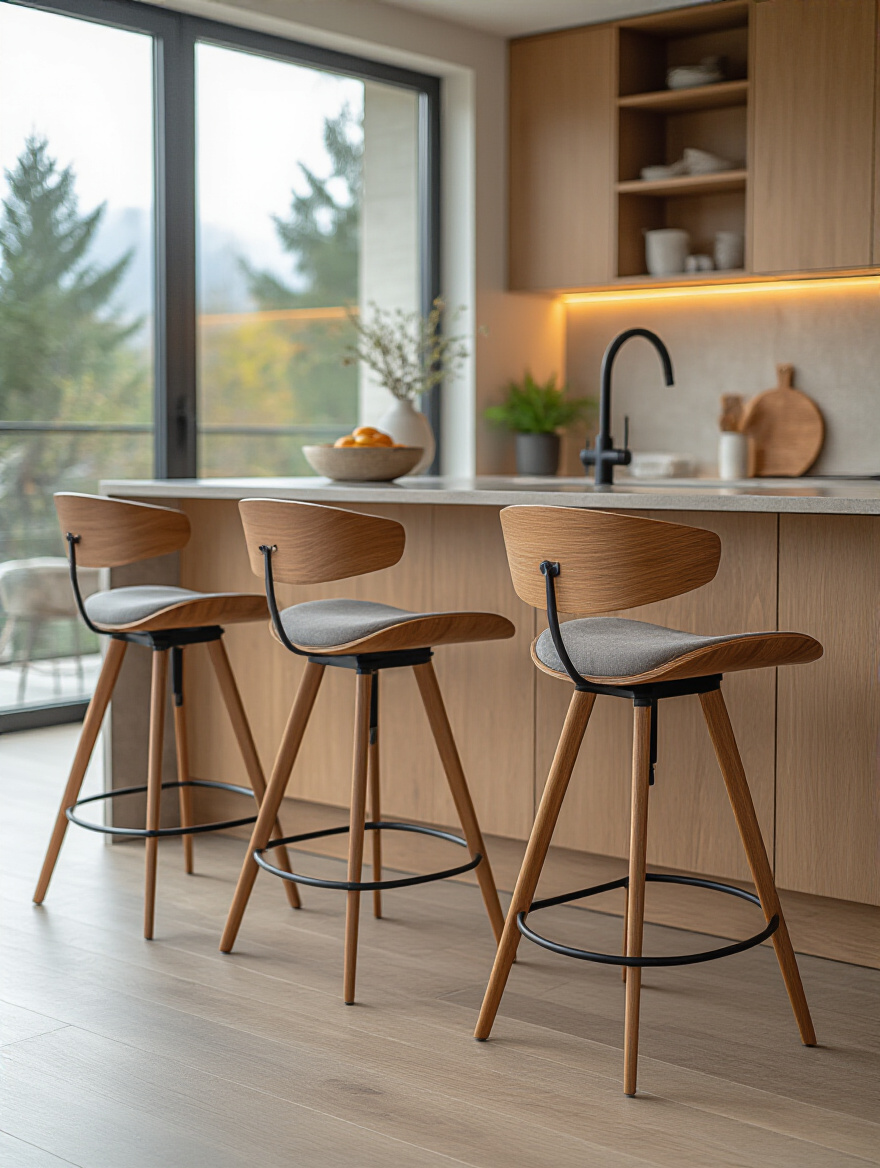
If grandparents visit often or if you plan to use the island for work, look for stools with proper back support. If you have kids, choose materials that are easy to wipe down. A swivel feature is fantastic for easy conversation and getting in and out without having to drag the stool across the floor. Style is important, yes, but comfort and function are what turn an island from a countertop into a true gathering place for the family.
Your seating provides a place to rest, but open shelving gives you a place to show who you are.
12. Curating Open Shelving with Decorative Yet Functional Items
People are terrified of open shelving. They imagine a cluttered mess that needs to be perfectly styled 24/7. But here’s the secret: it’s not for everything. Use open shelving strategically for the things you use every single day and the things you love to look at. For a coffee station, it’s perfect for holding beautiful mugs and canisters of beans. Near the stove, it can hold oils, spices, and a stack of your everyday plates.

The key to making it work is a ruthless edit. Don’t display your entire collection of mismatched souvenir mugs. Choose a cohesive set of dishes. Use beautiful containers to decant things like flour and sugar. Then, mix in a small plant, a piece of art, or a favorite cookbook. It’s about creating a moment of beauty and utility. When you limit open shelving to just one or two areas, it becomes a beautiful focal point rather than a storage nightmare.
Just as decorative items add visual softness, textiles add physical softness to a room full of hard surfaces.
13. Introducing Textured Textiles and Thoughtful Area Rugs for Softness
A modern kitchen can have a lot of hard, shiny surfaces—stone, tile, stainless steel. That’s what gives it that clean look, but it can also make it feel a bit cold and loud. The fastest way to add warmth and absorb sound is with textiles. A simple woven runner in front of the sink provides cushion underfoot and can introduce a pop of color or pattern. Soft Roman shades can soften a window, and even high-quality linen dishtowels hung from the oven handle can add a touch of texture.
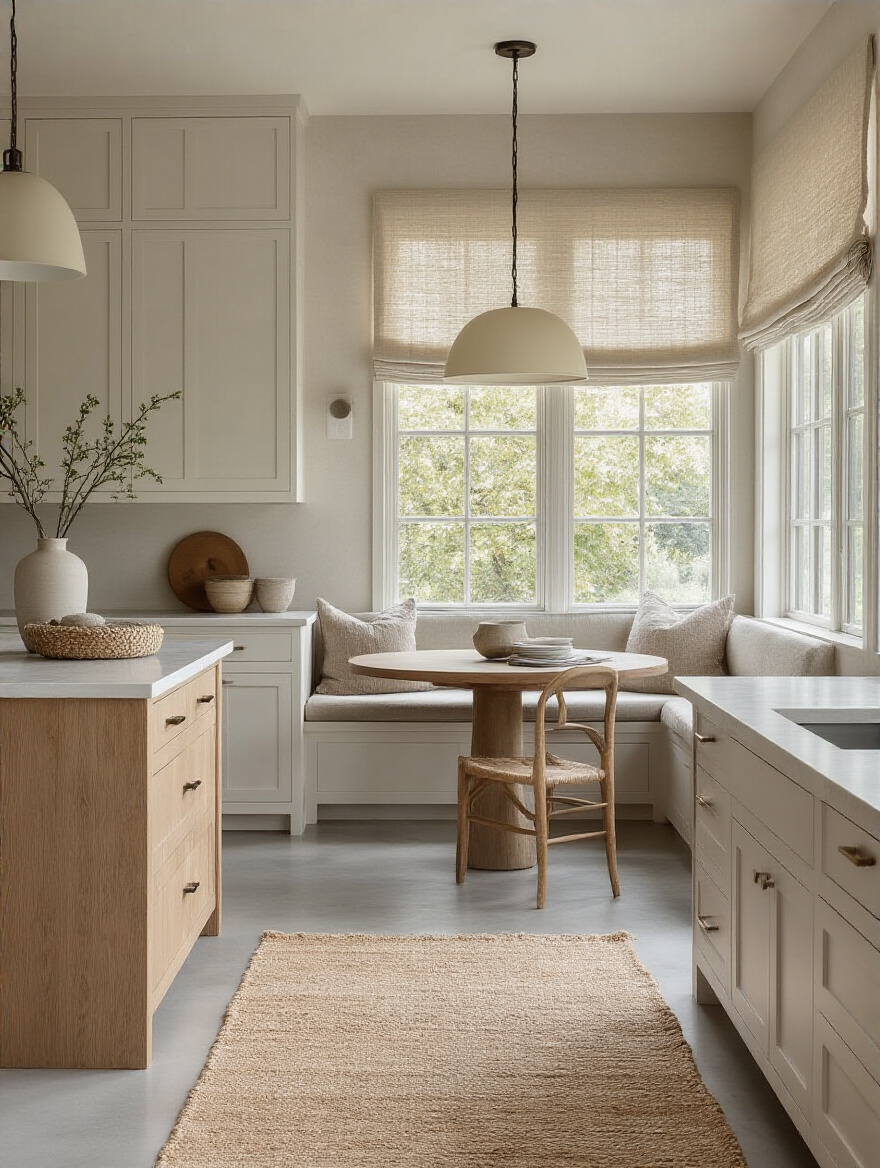
My go-to solution is a washable area rug. Companies like Ruggable make stylish rugs you can literally throw in the washing machine, which is a game-changer for a high-spill zone like the kitchen. It’s a brilliant way to define a space, add comfort, and bring in your personal style without committing to something permanent and high-maintenance. It’s the perfect example of modern design solving a real-life problem.
And one of the best ways to soften a space and literally bring it to life is with a touch of green.
14. Adding Live Greenery and Artistic Planters for a Touch of Nature
Nothing breathes life into a sleek, modern space like a living plant. It’s the perfect antidote to all those clean lines and hard surfaces. A small pot of herbs on the windowsill is not only beautiful and aromatic but also practical for cooking. A trailing pothos on top of the cabinets adds a sculptural, organic element. If you have the space, a larger fiddle-leaf fig in a beautiful ceramic planter can become a stunning architectural feature.

You don’t need a green thumb to make this work. There are tons of low-maintenance plants like snake plants or ZZ plants that thrive on neglect. The trick is to choose a planter that complements your design. Ditch the flimsy plastic nursery pot for something with substance and style—concrete, ceramic, or a minimalist metal planter can feel like a piece of sculpture. It’s a small touch that adds immense warmth, color, and vitality.
Bringing in natural elements is key, but so is adding things that tell a story.
Refining the Space: Styling and Personal Touches (Part 2)
We’re continuing with the layers that add personality. This is about making deliberate choices to display things that are meaningful to you, turning your kitchen from a generic “modern” space into your modern space.
15. Showcasing Unique Art Pieces or Sculptural Elements as Focal Points
Who says art only belongs in the living room? A kitchen is the heart of the home, and it deserves something beautiful to look at. Hanging a favorite painting or a collection of prints on a blank wall can completely transform the feeling of the room. It instantly elevates the space and makes it feel less like a utility zone and more like an integrated part of your home. It’s an unexpected touch that signals this is a room for living in, not just cooking in.
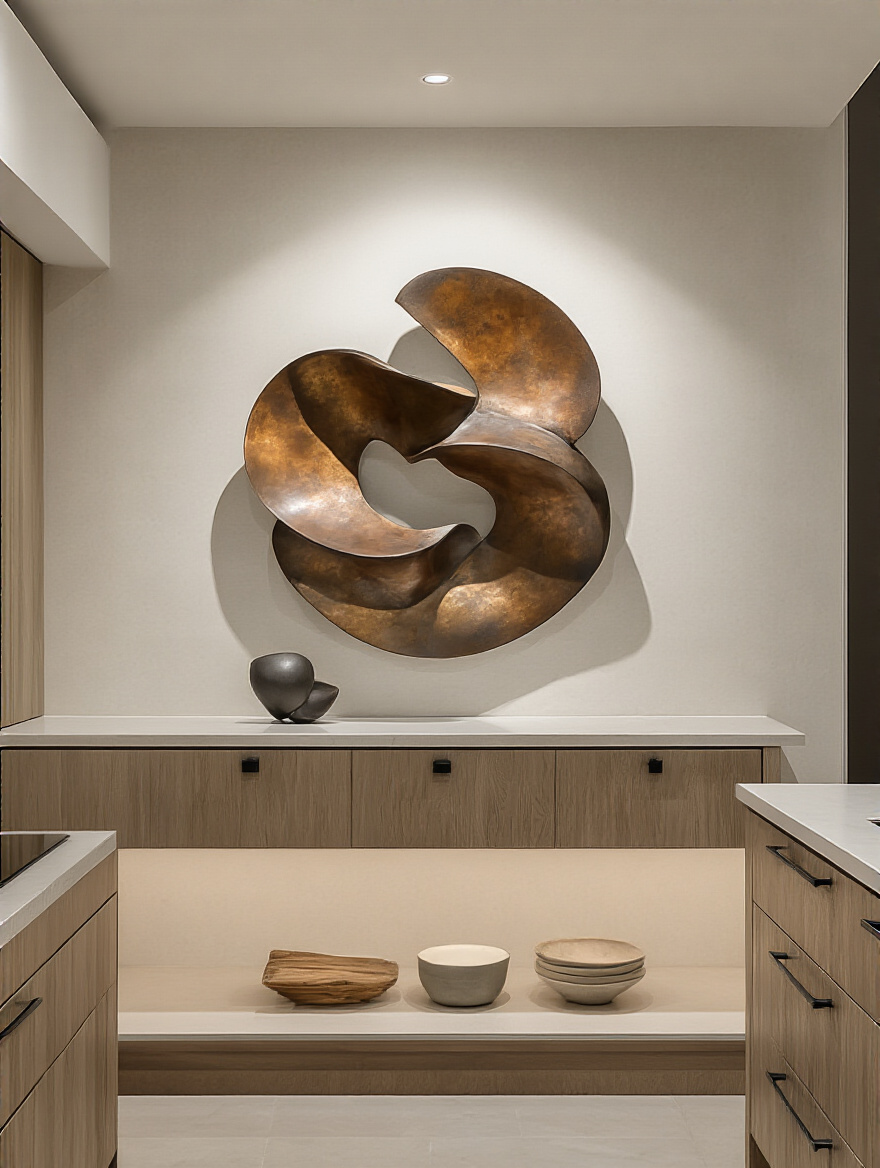
Don’t have a lot of wall space? Place a small sculpture or a beautiful piece of pottery on an open shelf or at the end of your island. I once worked with a client who put a striking ceramic vase on her counter and kept a single, dramatic branch in it. It was simple, sculptural, and an absolutely stunning focal point that required almost zero maintenance. Art doesn’t have to be expensive; it just has to be something that brings you joy.
With your kitchen designed and styled, the final step is to make sure it stays that way.
Optimizing & Maintaining: Sustaining Modern Elegance (Part 1)
You’ve created this beautiful, functional space. Now, how do you keep it that way? Sustaining that modern elegance isn’t about constant, deep cleaning. It’s about building simple, smart habits and systems that keep chaos at bay.
16. Implementing Strategic Decluttering for Continued Minimalism
A minimalist kitchen doesn’t magically stay minimalist. It requires a conscious effort to keep clutter from creeping back in. The most powerful tool I know is the “one in, one out” rule. If you buy a new coffee mug, an old one has to go. This simple habit prevents the slow, steady accumulation of stuff that ends up cluttering your cabinets and countertops.
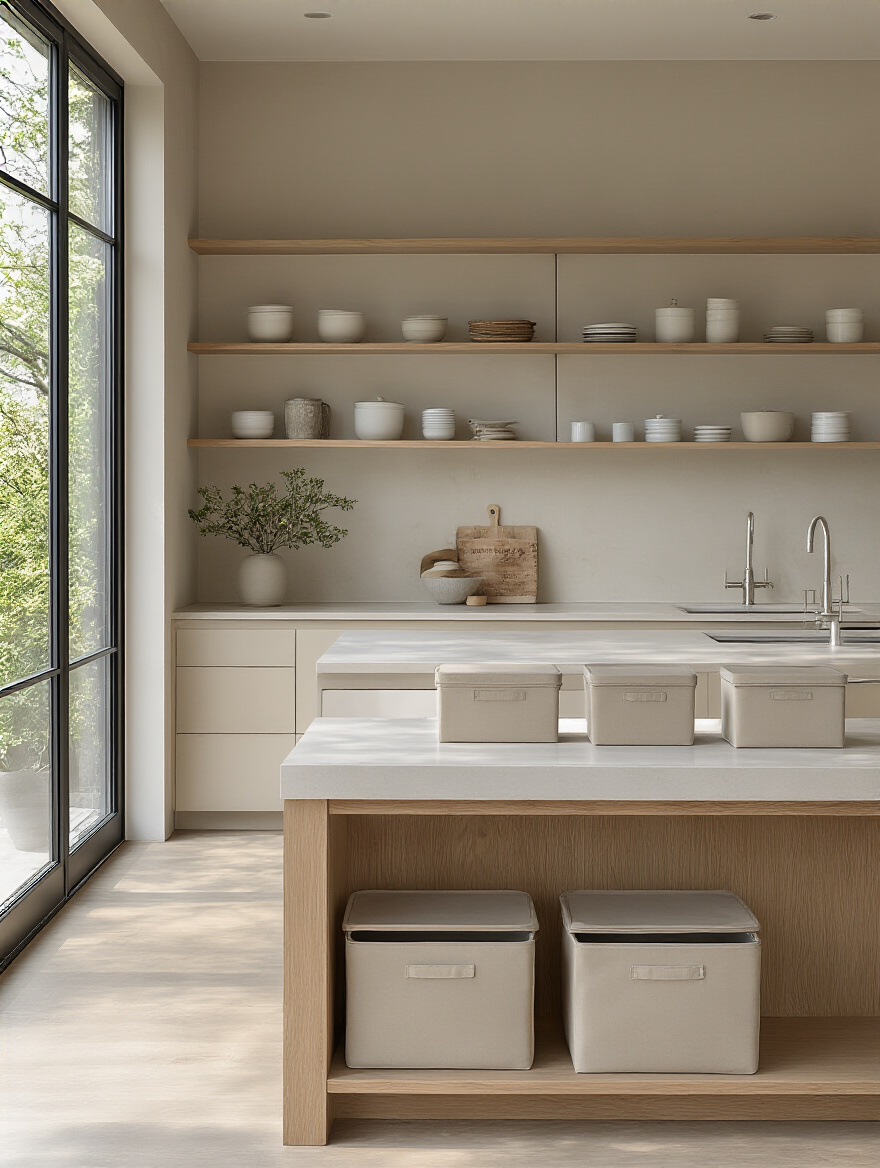
My other big shortcut is to create a “clutter basket.” We all have those things that pile up on the counter—mail, keys, sunglasses, random receipts. Instead of letting them spread, designate a single, attractive basket or bowl for them. Once a week, take five minutes to empty it and put everything back where it belongs. This contains the mess and keeps your beautiful surfaces clear, preserving that sense of calm and order you worked so hard to create.
A clutter-free space is much easier to maintain, which is our next focus.
17. Establishing a Consistent Maintenance Routine for All Finishes
The secret to keeping modern finishes looking brand new isn’t marathon cleaning sessions; it’s small, consistent actions. A spray bottle of the right cleaner for your countertop and a microfiber cloth stored under the sink is your best friend. Get in the habit of wiping down your counters every night after you do the dishes. It takes 60 seconds, but it prevents grime from building up and makes deep cleaning a much rarer event.
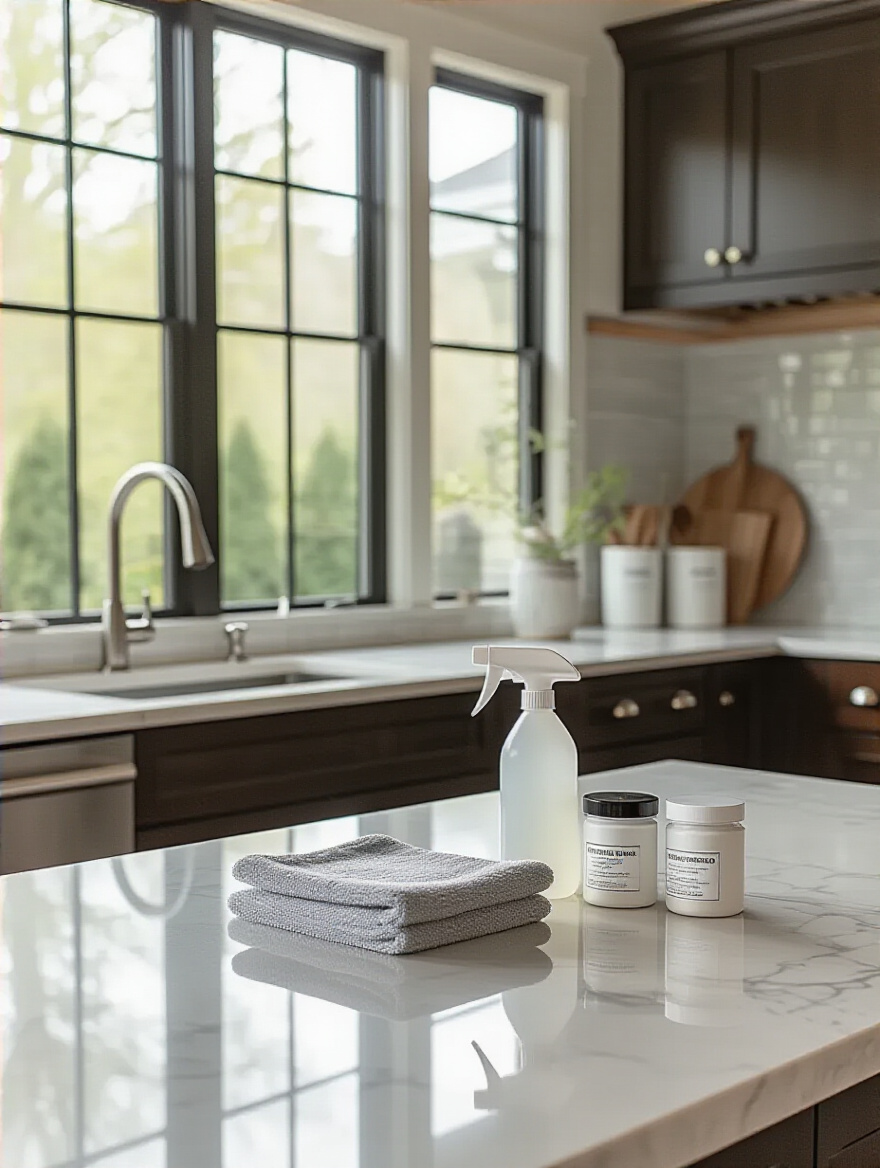
“Your finishes will love you for it. The best advice I can give is to read the care instructions from the manufacturer. Don’t use abrasive cleaners on matte cabinets or vinegar on stone countertops. Using the right product prevents damage and preserves the beauty of your investment for years.”
This is all about working smarter, not harder. A little bit of daily care is far less effort than hours of scrubbing once a month.
As your life changes, your storage needs will too, which is why flexibility is paramount.
18. Future-Proofing with Flexible and Adaptable Storage Solutions
The life you have today might not be the life you have in five years. Kids grow up, you might take up a new hobby like baking, or your dietary needs could change. A truly modern kitchen is designed to adapt. Instead of hyper-specific, built-in storage for one particular thing, opt for flexible solutions. Adjustable shelving is a must. Drawer dividers that you can move around are a game-changer.
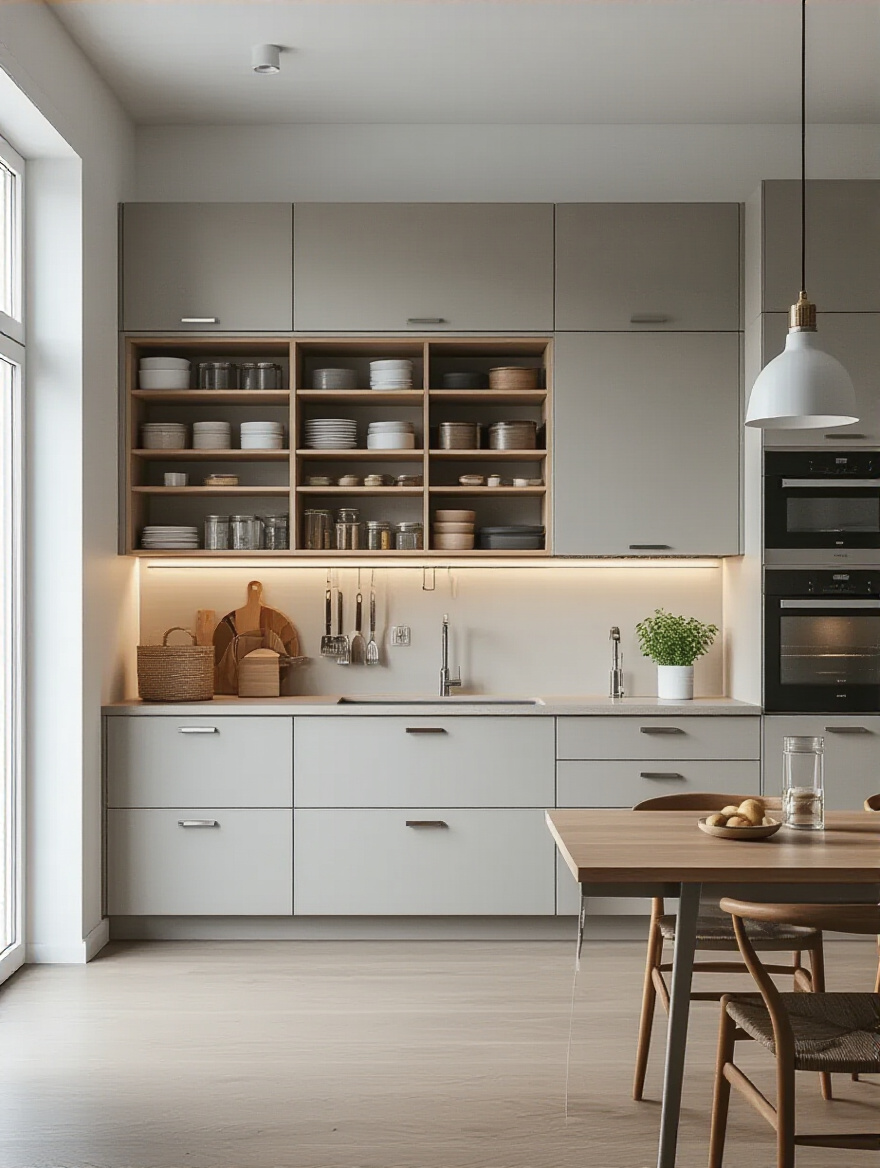
I love using pull-out pantry units. They bring everything into view and can be easily reconfigured. One year a shelf might hold baby food jars; a few years later, it can be adjusted to hold tall cereal boxes. This built-in adaptability means your kitchen can evolve with you without requiring a major renovation. It’s one of the most important principles of designing a home that will support you for the long haul.
While we want our kitchen to adapt to the future, bringing in pieces from the past can give it soul.
19. Repurposing Vintage Finds for Unexpected Modern Accents
There’s a risk that a perfectly designed modern kitchen can feel a little… generic. The perfect antidote is to add something with a story. A small vintage wooden stool tucked into a corner, a set of antique botanical prints on the wall, or a beautifully worn wooden cutting board leaning against the backsplash adds a layer of history and character that you just can’t buy new.
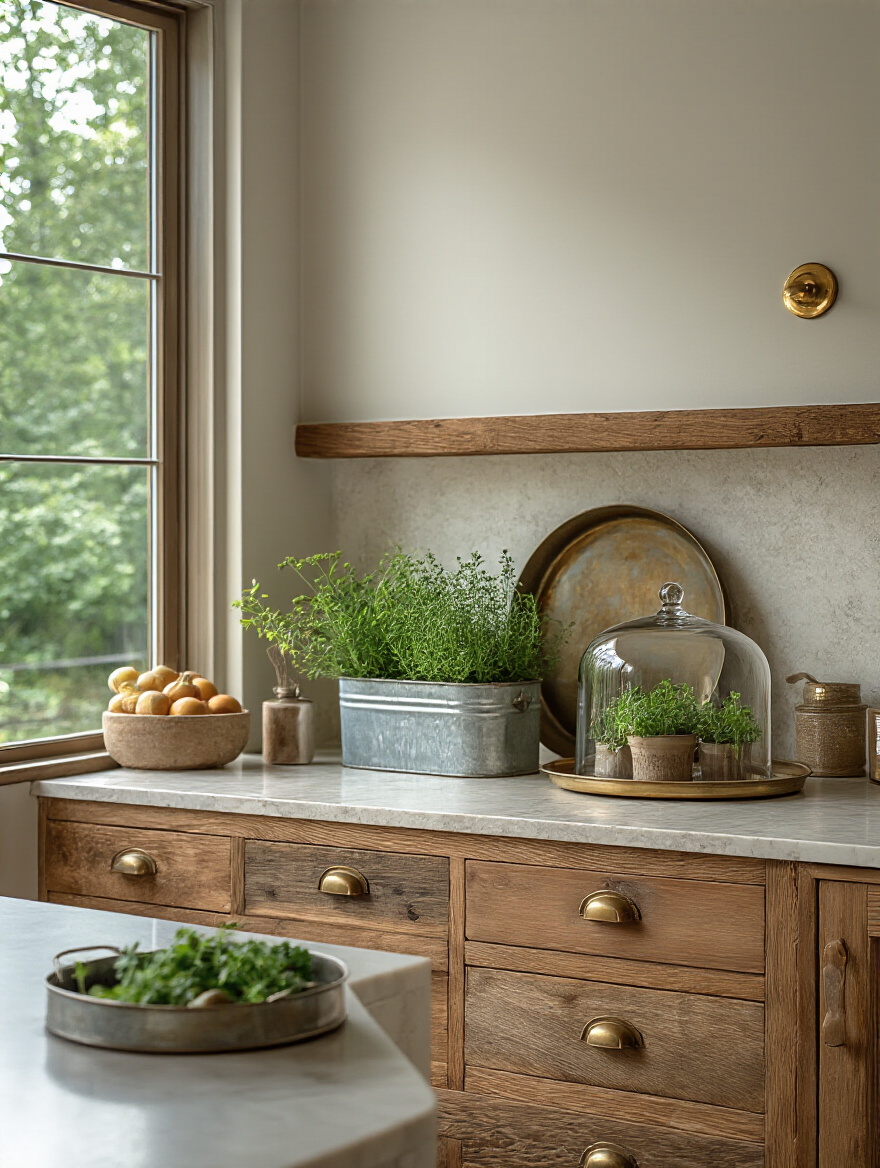
The trick is to use these pieces sparingly, as a deliberate contrast to the sleekness of everything else. It’s this juxtaposition of old and new that creates a dynamic, sophisticated look. It stops the room from feeling like a catalog and makes it feel like your home. I once saw a client use a small antique pharmacy cabinet as their spice rack, and it was the most charming, personal detail in the entire kitchen.
This idea of thoughtful curation leads us to our final, most important point.
Optimizing & Maintaining: Sustaining Modern Elegance (Part 2)
We’re at the home stretch. This last piece of advice is arguably the most important one for ensuring your investment of time, money, and energy pays off for decades to come.
20. Avoiding Over-Trends and Prioritizing Timeless Modern Design Principles
It is so tempting to fall for the “Color of the Year” or that specific tile pattern you’re seeing all over Instagram. But a kitchen is a long-term investment. My rule of thumb is this: keep your permanent, expensive choices classic and neutral. This includes your cabinets, countertops, flooring, and backsplash. These are the hard-working bones of your kitchen.
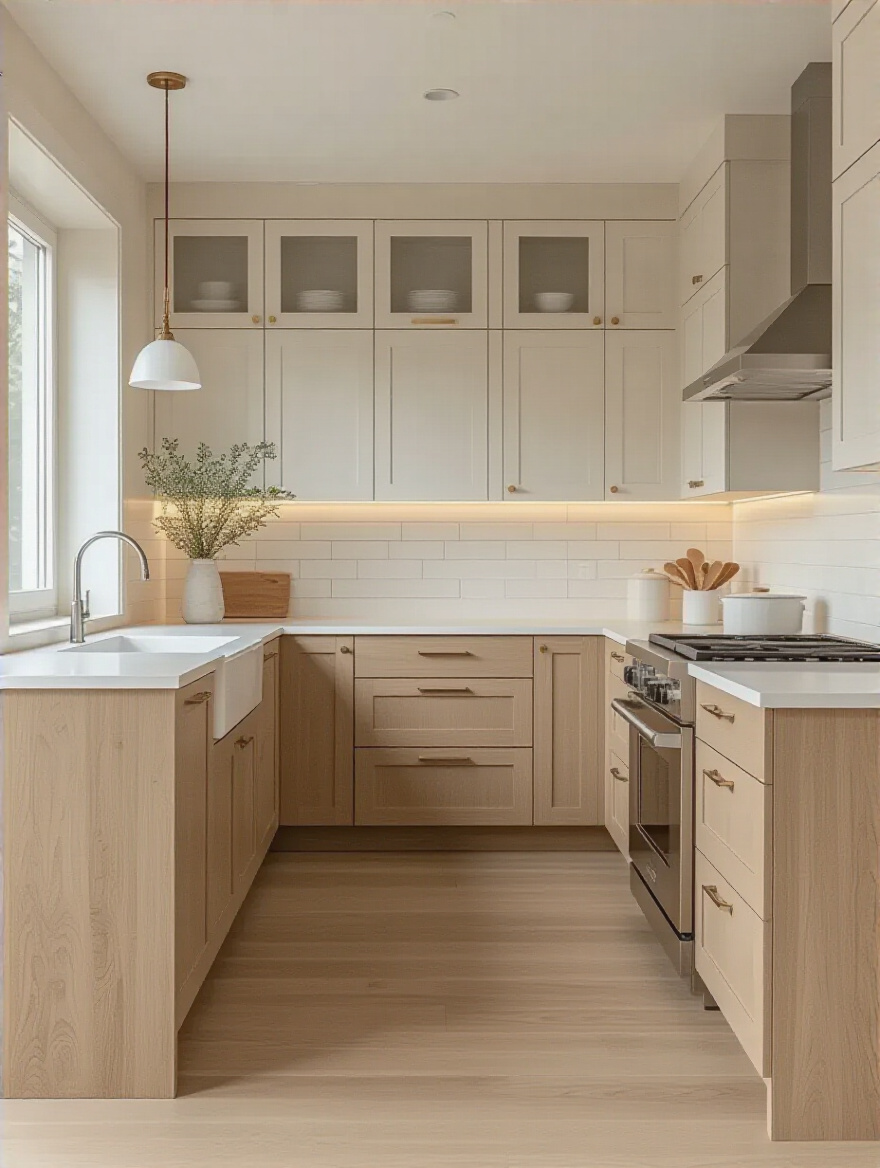
Save the trends for things that are easy and affordable to change. Go wild with paint color, cabinet hardware, light fixtures, bar stools, and accessories. These are the elements you can swap out in a weekend when you’re craving a fresh look. This approach guarantees your kitchen won’t feel dated in five years. It protects your investment and gives you the freedom to express your personality without committing to a trend that will fade. True, timeless modern design is about creating a beautiful, functional backdrop for your life, not a monument to a fleeting fad.
Conclusion
So, what is the real story of modern kitchen decoration? It’s not about achieving a sterile, picture-perfect space. It’s about creating a kitchen that works for the beautiful messiness of real life. It’s about smart, inclusive design that makes everyday tasks a little bit easier and a lot more joyful. It’s a kitchen that can host a chaotic family breakfast on Tuesday and a quiet, elegant dinner party on Saturday. It’s a space that grows and adapts with you through every stage of life.
Your home should be your sanctuary, and the kitchen is its heart. By focusing on a foundation of quality materials, thoughtful flow, and flexible function, you can create a space that feels both stylish today and timeless tomorrow. Don’t be afraid to make it your own. Take these ideas, be honest about how you live, and build the kitchen that truly supports you and the people you love. Your dream kitchen isn’t just a beautiful space; it’s a better way to live.
